The Modern Majlis: Blending Tradition with Today's Design

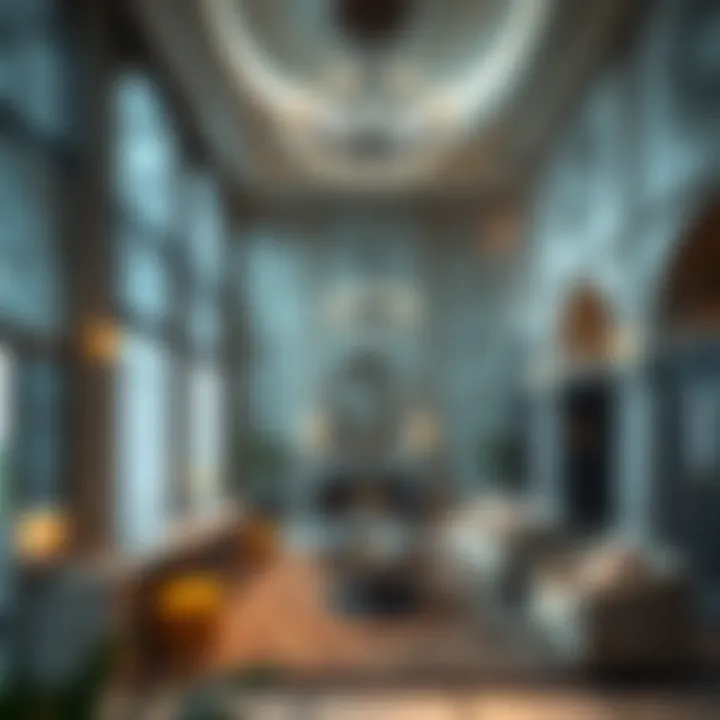
Intro
The majlis, a traditional gathering place, is more than just an architectural structure; it embodies the essence of hospitality and communal bonding in Emirati culture. In today's Dubai, the majlis has transformed dramatically, bridging past and present in a remarkable way. Amid the glitz and glam of one of the world’s most rapidly evolving cities, this space holds its ground as a cultural touchstone—serving not only as a venue for family gatherings but also as a reflection of broader societal values.
Understanding the majlis today requires a closer look at its evolution, its role in various social contexts, and its place within the real estate landscape of Dubai. Investors and real estate buyers, particularly those with an appreciation for cultural nuance, will find much to gain from understanding how these traditional spaces are adapted to meet contemporary demands.
In this article, we will dissect the multifaceted nature of the modern majlis, looking at how it retains cultural significance while accommodating the fast-paced lifestyle of urban living. Delving into recent trends in the real estate market, we aim to shed light on the architectural innovations that merge traditional elements with contemporary design. We will also explore investment opportunities and the nuances that make the majlis a significant consideration for potential buyers and investors in Dubai's dynamic property market.
As we venture through these topics, readers can expect an insightful examination of how the majlis stands as both a historical monument and a modern necessity, reinforcing its role within not only residential but also commercial spaces.
Understanding the Majlis Concept
The majlis holds a noteworthy place in the cultural fabric of Middle Eastern societies, particularly in the United Arab Emirates. It serves as more than just a physical space; it embodies a rich tradition of hospitality, community engagement, and cultural identity. In today’s evolving landscape, understanding the majlis concept is crucial for investors, buyers, and developers, as it reflects not only the sociocultural values of the region but also affects property values and architectural trends. This topic serves as the foundation for comprehending how the majlis has adapted to contemporary needs while remaining deeply rooted in tradition.
Historical Background
The origins of the majlis date back several centuries, serving as communal areas where tribal leaders and community members congregated for discussions, decision-making, and social bonding. Traditional majlis were often built from locally sourced materials and featured intricate designs that reflected the craftsmanship of the time.
Historically, these spaces were simple yet functional, designed to accommodate men primarily, although modern interpretations have evolved to welcome all genders and age groups. The architectural features of past majlis included low seating arrangements, often adorned with cushions and carpets, which were integral to the welcoming atmosphere. The transition from outdoor to indoor settings, as urbanization progressed, showcased a shift in design but kept the essence intact. The modern majlis, while embracing contemporary elements, strives to maintain this connection to its roots. This historical evolution highlights the adaptability and resilience of cultural practices in a rapidly changing society.
Cultural Significance
Culturally, the majlis remains a vital component in the social landscape of Dubai and wider UAE. It is a symbol of hospitality, reflecting the Middle Eastern ethos of welcoming guests with open arms. Within these walls, conversations unfold, ideas are shared, and community bonds are strengthened. The majlis serves as a space for informal gatherings, celebrations, and even conflict resolution.
- Social Functions: Majlis gatherings are not just social; they often play a role in community decision-making, strengthening ties and fostering a sense of belonging.
- Promoting Heritage: In a world increasingly influenced by globalization, the majlis represents a bastion of cultural identity. It embodies the values of respect, conversation, and togetherness that are central to Emirati lifestyle.
- Impact on Design Trends: Understanding the cultural weight of the majlis can guide architects and interior designers toward creating spaces that honor tradition while catering to modern aesthetics and functionality.
As such, recognizing the majlis's historical context and cultural implications is crucial for anyone engaged in real estate, architecture, or community planning within Dubai. The intersection of tradition and contemporary design not only enhances aesthetic appeal but also enriches the social fabric, making the majlis a focal point of community life.
"The majlis is not just a room; it’s where the heart of a community beats, echoing the values of hospitality and togetherness."
Understanding this concept allows for a better appreciation of its role in functioning as an enduring symbol of unity and cultural significance, particularly in today’s urbanized settings. As real estate developers and investors contemplate the majlis’s place in modern architecture, it becomes evident that this dynamic space is more than a design choice—it’s a necessary element of cultural sustainability.
Characteristics of a Modern Majlis
The majlis, traditionally a gathering space, has evolved in modern society to reflect contemporary aesthetics while embracing its rich cultural heritage. This section focuses on the essential aspects that define a modern majlis, emphasizing their architectural features and interior design elements. As urban centers grow and lifestyles change, understanding these characteristics becomes crucial for investors, buyers, and developers alike, who seek to capture the essence of Dubai's architectural landscape.
Architectural Features
When one walks into a modern majlis, the architectural side often takes one’s breath away. Spaciousness is a keystone in the design, with open layouts that encourage interaction. High ceilings adorned with intricate latticework let in ample sunlight, illuminating these spaces beautifully. Large windows offer views of the outside world, blending nature with interior tranquility.
Architects today emphasize functionality in design while retaining aesthetic appeal. For instance, the use of curvilinear forms enhances flow and movement, allowing for versatile configurations. This approach not only appeals to the eye but also fosters community interactions.
"The majlis encapsulates the spirit of hospitality; it serves as a bridge between the past and present, where traditions meet the comforts of modernity."
Interior Design Elements
Interior design within a modern majlis tells a story, combining elements of tradition with contemporary needs. Key design features include the careful selection of color palettes, furnishings, and decorative pieces that reflect cultural identity while being adaptable to modern tastes.
Use of Traditional Fabrics
Incorporating traditional fabrics can add depth to the majlis's character. Rich textiles, like brocade and cotton, not only furnish the space but also evoke the region's heritage. These materials are significant as they speak volumes about craftsmanship and local artistry.
The choice of fabrics often supports a warm, inviting ambiance, enticing guests to sit and linger. Intricate patterns found in traditional cloth can tell ancestral stories, creating a cozy sense of belonging. Additionally, these fabrics are typically durable, ensuring longevity in modern homes.
However, the maintenance of these fabrics can sometimes pose a challenge, requiring careful cleaning and preservation to uphold their beauty.
Integration of Technology
Contrasting tradition with modernity, the integration of technology plays a pivotal role in evolving the majlis. Smart home features, such as automated lighting and climate control systems, are becoming commonplace. This tech adds convenience while ensuring comfort during gatherings.
Devices like smart screens can enhance entertainment options within the majlis, making it easier for hosts to showcase visual content during social events. Moreover, integrating seamless audio systems can create an inviting atmosphere for conversations without disrupting the traditional aesthetics.
This fusion of technology feels like a natural extension rather than an intrusion. However, it's crucial to ensure that these modern elements do not overshadow the rich traditions that give the majlis its identity.
Functional Roles of the Majlis

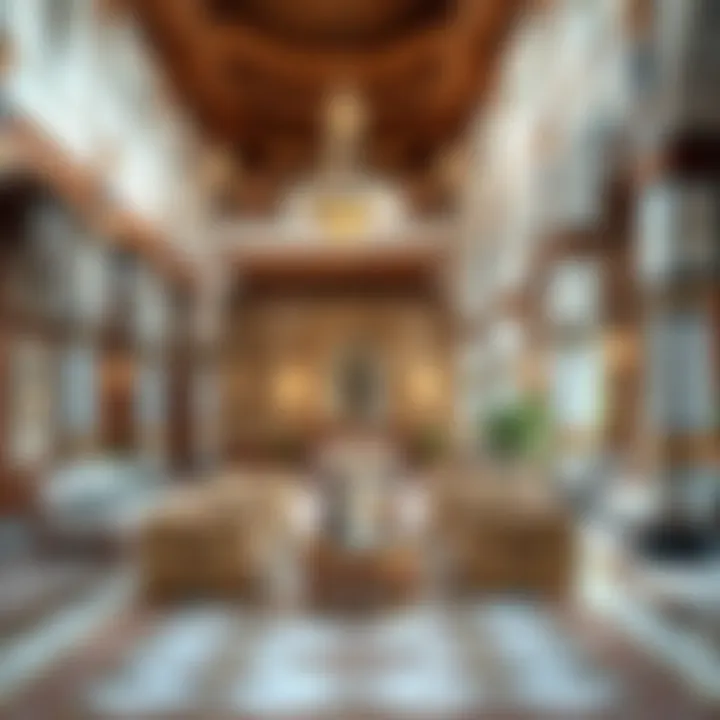
The majlis serves not only as a physical space but also as a social and cultural institution deeply embedded in the fabric of Emirati life. Recognizing its multifarious roles can provide investors, buyers, and developers with valuable insights into its significance in both community cohesion and commercial enterprises. Understanding the functional roles of a modern majlis opens the door to see its vitality in urban settings, bridging the gap between traditional values and modern aspirations.
Social Gatherings and its Importance
A majlis is a sanctuary for social interaction where people gather to share stories, celebrate milestones, or engage in casual chats over coffee and dates. These gatherings are particularly important in fostering community ties, amid the swift pace of urban life where such connections can easily be lost.
- Cultural Preservation: In these meet-ups, individuals discuss matters of communal concern, ensuring that cultural narratives and local traditions are kept alive. The majlis acts as a living archive of heritage where elders impart wisdom to the younger generations.
- Social Dynamics: It is in these informal settings that friendships are nurtured. Often, significant decisions are made here—not just in personal lives but in broader community issues.
The majlis shapes cohesion, creating an anchor point for various emotions and expressions, from joy to grief. As a result, it provides emotional support and a sense of belonging for many, making it critical in the social fabric of modern Dubai.
Business and Networking
The functional role of the majlis extends into the business domain, making it an invaluable asset for professionals seeking to build networks. Here, the lines between business and personal interactions blur, fostering an environment conducive to establishing trust and partnerships.
- Business Deals: Many entrepreneurs and executives prefer closing deals in their majlis. The relaxed atmosphere encourages open dialogue, where honesty and integrity take precedence over formalities. These settings allow discussions that might not happen in a boardroom.
- Networking Opportunities: The majlis acts as a melting pot for various industries, creating occasions for meaningful connections. Entrepreneurs often benefit from face-to-face interactions, leading to collaborative ventures or referral opportunities.
Additionally, the majlis provides a platform where businessmen can gauge community sentiments and adapt their strategies accordingly. Recognizing the social cues within these gatherings can lead to better market alignment.
"The majlis is not just a place; it's a cornerstone where culture, business, and community converge."
In essence, the majlis transcends its physical structure. It dovetails traditional Emirati values into the rhythm of contemporary life while sustaining relevance for future generations. To investors and developers, understanding these roles gives them a more holistic view of real estate opportunities intertwined with cultural significance.
Understanding the majlis's functional roles allows stakeholders in the real estate sector to appreciate the layers of meaning and utility that this space embodies, transforming it from mere architecture into a potent community resource.
For further insights into modern majlis functions, check out:
The majlis may seem like a simple room at first glance, but when observed from the perspective of business, tradition, and community, its potential becomes abundantly clear.
Modern Adaptations in Urban Contexts
The evolving landscape of urban living calls for understanding how traditional elements, like the majlis, are adapting in modern contexts. In cities such as Dubai, where tradition coexists with rapid development, the majlis emerges not just as an architectural feature but as an essential social space. These modern adaptations blend age-old practices with contemporary needs, enhancing both community interactions and property desirability.
Open-plan Designs
One prominent trend in contemporary majlis architecture is the open-plan design. This layout promotes an inclusive atmosphere that aligns with the inherent purpose of the majlis as a communal gathering place. Visitors can easily flow between spaces, whether they are engaging in business discussions or enjoying casual conversations. The seamless transition enhances social connections and embodies the essence of hospitality that a majlis signifies.
Consider a modern majlis with expansive windows that allow a flood of natural light, accentuating the open space. The arrangement often combines seating areas with minimal barriers, creating a welcoming environment. Homes designed this way might include multipurpose furniture, which serves both aesthetic and functional roles, allowing for spontaneous gatherings without the rigid formality of traditional designs.
"The open-plan layout not only reflects modern sensibilities but invites greater interaction among guests, thus upholding the majlis's social essence."
Incorporating Outdoor Spaces
Today’s majlis often stretches beyond the four walls, incorporating outdoor areas into their design. These spaces play a crucial role in fosterin connection with nature and versatility in gatherings. By blending indoor and outdoor living, the majlis caters to the urban lifestyle while honoring the cultural norm of gathering outdoors.
Incorporating outdoor spaces can manifest in various ways:
- Terraces and Patios: Offering open-air options for gatherings, these areas often contain shaded seating or even fire pits for cooler nights, encouraging longer social interactions.
- Garden Elements: Floral arrangements or greenery can create a serene atmosphere, making outdoor areas visually appealing and calming, perfect for both casual tea sessions and more formal receptions.
- Outdoor Fireplaces or Grills: These elements can enhance gatherings, allowing for outdoor culinary experiences that reflect traditional practices while embracing modern lifestyle preferences.
Ultimately, these aspects of modern majlis design reflect a thoughtful approach to combining traditional values with the demands of today's urban lifestyle. Understanding these adaptations is crucial for investors and developers who recognize the cultural significance and property value of well-designed gathering spaces.
The Role of Majlis in Real Estate Development
In the landscape of Dubai’s ever-evolving real estate, the majlis has a pivotal role that goes beyond mere aesthetics. It acts as a cultural linchpin, bridging past traditions with modern lifestyles. Buyers, investors, and developers must grasp the significance this space carries in both residential and commercial contexts. By understanding its influence, stakeholders can make informed decisions that resonate with the cultural landscape while maximizing returns.
Impact on Property Values
The majlis is more than just a room in a house; it embodies the essence of hospitality and community in Emirati culture. This cultural significance positively affects property values. Properties featuring a well-designed majlis often command higher prices. Buyers appreciate spaces that reflect local traditions. They are willing to pay a premium for a home that provides an environment where family gatherings and social interactions flourish. A majlis creates a sense of belonging, which is particularly appealing in a cosmopolitan city where expatriates and locals alike seek connections to heritage.
Consider the following points when analyzing the impact on property values:
- Cultural Authenticity: Properties with a majlis enhance cultural authenticity, making them more appealing to culturally aware buyers.
- Enhanced Functionality: A well-integrated majlis increases the utility of a home, serving as a multifunctional space for entertainment, meetings, or simply relaxation.
- Market Demand: There’s a growing trend towards culturally themed properties in Dubai, and a majlis can be a selling point that distinguishes a property in a crowded market.
Overall, the majlis contributes to an increase in property desirability, reflecting the need for heritage in a modern setting.
Marketing Strategies for Developers
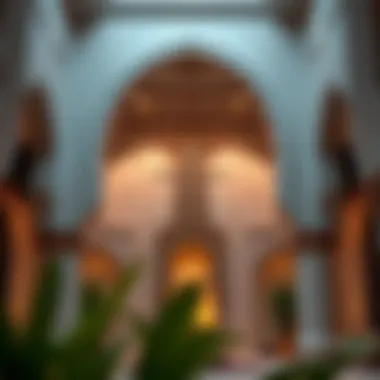
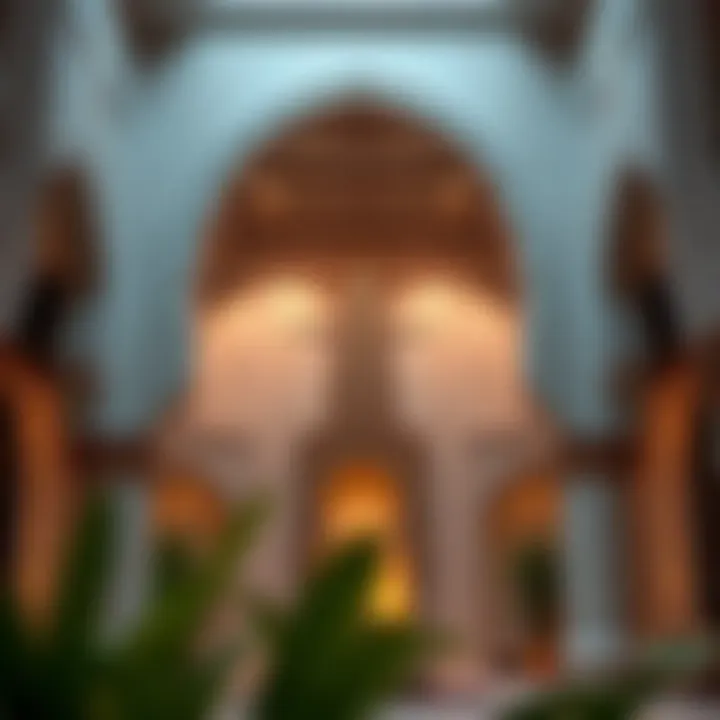
When developers tap into the majlis’s appeal, they invite potential buyers to envision the traditional yet modern lifestyle that Dubai offers. Effective marketing strategies can highlight the majlis's unique characteristics, making properties not just houses but homes steeped in culture. Here are key strategies:
- Storytelling Approach: By weaving narratives around the majlis that emphasize its community significance, developers can create emotional connections. For example, sharing stories about how families gather during holidays can resonate deeply with prospective buyers.
- Visual Presentation: High-quality visuals showcasing the majlis in various settings can be powerful. Images that capture gatherings or serene moments in this space can spark interest in potential buyers.
- Targeted Advertising: Utilize platforms like Facebook and Instagram to target ads that highlight properties with majlis features to culturally engaged audiences. This helps to reach a demographic that values tradition and modernity simultaneously.
- Showcase Versatility: Highlight the majlis’s adaptability. Whether it’s a family Ramadan gathering or a business meeting, showcasing its multifunctionality can appeal to a broad audience.
Investment Opportunities in Majlis-centric Properties
The majlis isn’t just a cultural touchstone; it has evolved into a space offering unique investment opportunities. Understanding these prospects is vital for investors looking to tap into Dubai's vibrancy. Recent trends indicate that properties with a dedicated majlis space not only enhance marketability but also capture a segment of buyers searching for authenticity and cultural richness. The majlis plays a pivotal role in bridging traditional values and modern aesthetics, making it a focal point in real estate discussions.
One key consideration is the appeal of properties that embody the majlis concept. These homes boast enhanced architectural styles and integrate communal aspects, fostering societal ties. A majlis allows for gatherings that emphasize connection, be it for family, friends, or business associates. This charm can be a strong selling point.
Furthermore, as Dubai continues its rapid development, the demand for properties with unique characteristics will only increase. Keeping this in mind helps investors align their strategies with the growing appetite for culturally relevant homes. In addition, looking into surrounding amenities and community integration can play a crucial role in determining the long-term viability of such properties.
Investing in majlis-centric properties creates opportunities for financial growth while preserving the rich cultural narrative of the region.
Luxury Developments
Luxury developments featuring a modern majlis have emerged as hotspots for discerning buyers. These upscale projects not only reflect opulence but also infuse traditional elements, enriching the aesthetics and functionality. For instance, thought-provoking designs that incorporate floor-to-ceiling windows can soar in attracting buyers, tapping into panoramic views of the city or beautifully landscaped gardens. The idea of combining luxury living with the majlis is appealing to a wide range of potential homeowners seeking a prestigious label alongside a slice of cultural heritage.
Additionally, luxury developments may highlight unique selling propositions such as exclusivity, state-of-the-art finishes, and bespoke interior designs which cater to an affluent clientele. Investors thus stand to gain from a competitive edge by focusing on properties that encompass these features.
Potential for Rentals
Properties featuring a majlis also boast significant rental potential. With the rise of expatriates and tourists flocking to Dubai year-round, a thoughtfully designed majlis can enhance the overall appeal of a property on rental platforms. Many tenants seek cultural familiarity and comfort, making majlis-centric homes attractive options for long-term leases.
Moreover, short-term rental opportunities in platforms like Airbnb can yield lucrative returns as well. Properties with a majlis create a unique selling point, as they provide visitors a taste of authentic Emirati hospitality. They become more than just a place to stay; they offer an experience enriched by tradition.
To maximize this potential, landlords should invest in maintaining the majlis' aesthetics and functionality, ensuring they remain appealing to renters. This becomes essential as discerning tenants increasingly look for properties that offer not just shelter but a true connection to Dubai’s vibrant cultural fabric.
By understanding both the allure and practical advantages of majlis-centric properties, investors can navigate the market more effectively, ensuring robust returns while fostering a deeper appreciation for a significant cultural space.
Environmental Considerations in Design
The majlis is not just a passive participant in the realm of architecture; it plays an active role in shaping and redefining our understanding of sustainable living. With increasing emphasis on environmental issues, the need for eco-friendly designs has never been more pressing. The integration of environmentally conscious design practices into the majlis reflects a harmonious balance between traditional values and contemporary demands. This approach not only enhances the aesthetic appeal of these gathering places but also fosters a sense of community responsibility, promoting a culture of care for our surroundings.
Sustainable Materials
When designing a modern majlis, the selection of materials stands out as a critical factor for sustainability. Choosing ethically sourced materials can profoundly influence both the creation and the eventual life cycle of the structure. Traditional items, such as local stone and timber, not only contribute to the majlis's cultural authenticity but also minimize transportation emissions due to their proximity.
While local materials are crucial, modern innovations have brought about eco-friendly alternatives—like recycled metal or sustainable composites—that allow for creative expression without harming the environment. This combination of the old and the new creates a space that resonates with heritage, while being equipped for the future.
Benefits of Using Sustainable Materials
- Reduced Environmental Impact: By prioritizing locally sourced and renewable materials, developers can substantially lower their carbon footprint.
- Enhanced Durability: Sustainable materials often come with higher quality and longevity, decreasing the need for frequent repairs and replacements.
- Cultural Relevance: Using traditional building materials underscores local heritage, fostering a connection between the structure and its community.
Considerations in Material Choice
Before making choices, it is paramount to consider:
- The lifecycle of materials: from extraction to disposal.
- The energy used in production and transportation.
- Potential health impacts of the materials chosen.
Energy Efficiency
In today's fast-paced world, energy efficiency is more than just a trend; it has become a necessity. Designing a majlis that focuses on efficient energy use is not only environmentally responsible but also economically advantageous in the long run. Incorporating features such as solar panels, well-insulated walls, and energy-efficient lighting can reduce operational costs significantly.
Key Elements of Energy-Efficient Design
- Natural Ventilation: Strategically placing windows and openings can allow fresh air circulation, minimizing reliance on mechanical systems for heating and cooling.
- Smart Home Integration: Modern majlis can benefit from smart systems that monitor and control energy use, offering insights into consumption patterns and enabling users to find areas for improvement.
- Landscaping for Energy Efficiency: Thoughtful landscaping can reduce heat absorption and improve cooling. For example, surrounding the structure with trees can provide shade, lowering indoor temperatures naturally.
Long-term Benefits of Energy Efficiency
- Lower Utility Costs: As energy prices climb, homes designed with efficiency in mind will save owners a considerable amount over time.
- Increased Property Value: Energy-efficient properties may appeal more to buyers and tenants, leading to higher market prices.
- Enhanced Comfort: Efficient designs can lead to better indoor air quality and overall comfort.
The majlis symbolizes more than just aesthetics; it's a gateway to sustainability. By employing eco-conscious design principles, we pave the way for a more resilient future.
For deeper insights on sustainability, you might explore resources like Wikipedia or Britannica.
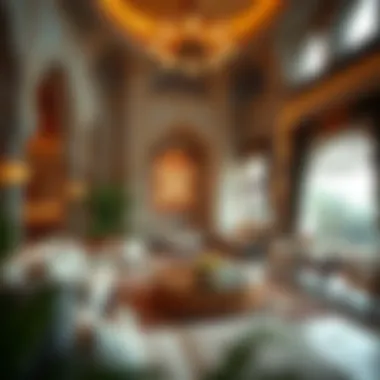
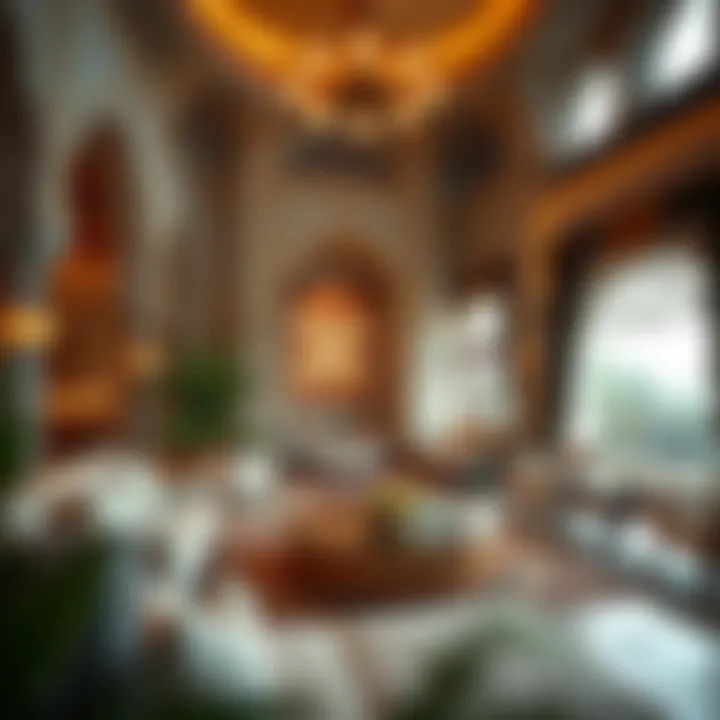
Community and Social Responsibility
The concept of community and social responsibility plays a crucial role in the evolution of the majlis, particularly as we witness the juxtaposition of traditional values with modern societal needs. As the residential and commercial landscapes of Dubai shift, the majlis emerges not only as a physical space but as a symbol of communal values and interpersonal bonds. Understanding its function far beyond mere architecture is essential for investors and developers looking to establish connections in the local market.
The majlis has long been a space for discussions and gatherings, and its significance is amplified in a modern context where such interactions are pivotal. It serves as a bridge between diverse cultural backgrounds, allowing various social narratives to thrive. The majlis facilitates dialogue among communities, fostering understanding and cooperation—a vital attribute in today’s increasingly globalized world.
The Majlis as a Community Hub
In suburban environments, the majlis stands as a community hub, where social and cultural gatherings take place, making it inclusive rather than exclusive. This function opens doors for hosting events, from festivals to workshops, encouraging local artisans and businesses to showcase their talents and products. A well-integrated majlis encourages participation from all walks of life, thus helping to preserve local customs while embracing new trends.
- Regular gatherings in the majlis strengthen social bonds, serving as a venue for family reunions, friendship celebrations, and even community forums.
- Events focused on education, such as book clubs or cultural discussions, can promote learning and a deeper understanding of shared heritage.
- The majlis can also support charitable causes, with gatherings organized to raise funds for community projects or local charities, enhancing the majlis's reputation as a socially responsible entity.
Promoting Cultural Awareness
The majlis operates not just as a physical entity but as a vital instrument for promoting cultural awareness. In a city like Dubai, with its melting pot of cultures, the majlis becomes a potent reminder of the significance of preserving one's roots while embracing diversity. Celebrating cultural festivals and events within the majlis encourages dialogue about the richness of heritage, effectively weaving threads from different cultures into the fabric of community life.
For developers, creating spaces that reflect this cultural keystone is paramount. A thoughtfully designed majlis can attract both locals and expatriates, allowing them to interact and appreciate the historical context while exploring modern shoes that modern living provides.
"A home without a majlis is like a body without a soul; it brings the community together and celebrates its diversity."
In summary, the majlis is not just an architectural feature but a touchstone for engagement and enlightenment in contemporary society. As individuals navigate investment decisions or property developments, recognizing the majlis's role in community cohesion and cultural appreciation is vital. Understanding these aspects can enhance the social fabric of communities in Dubai, making the majlis an essential element to consider in any development project.
Challenges and Considerations
Navigating the modern majlis’ landscape offers unique challenges and considerations. These hurdles often shape the way this traditional space evolves in today's contemporary world. Understanding these challenges is critical for investors, buyers, and developers who wish to comprehend the nuanced balance between cultural heritage and modern-day functionality.
Balancing Tradition with Modernity
Achieving the right mix between tradition and modernity is a slippery slope. Many property buyers are drawn to the majlis concept because of its rich cultural roots. However, the modern buyer often desires more functionality than the classic design offers. Taking this into account, designers face the difficult task of preserving the essence of the majlis while integrating contemporary elements. Some may incorporate new materials or alter layouts to enhance utility, but, in doing so, they risk straying too far from the original meaning of the space.
When designing a modern majlis, it's essential to consider:
- The layout: Should it reflect a more open design to allow for easy flow and socializing?
- The furnishings: Should traditional seating be swapped out for contemporary forms, or should both be used in harmony?
- The ambiance: How can you preserve the welcoming, intimate spirit of the majlis amidst a modern design?
These takeaways reflect the delicate dance that architects and interior designers must master. Successfully balancing these elements can enhance a majlis’s appeal, boosting its value and desirability among potential buyers.
Regulatory Constraints in Design
Navigating regulatory constraints can feel like navigating a minefield. Various laws and regulations may dictate design elements like height, materials, and even aesthetic preferences, especially in urban developments. When creating a modern majlis, designers must ensure compliance with local codes and regulations while still pursuing creative freedom.
Some considerations related to regulatory constraints include:
- Zoning Laws: In densely populated urban areas, zoning regulations can restrict the extent to which a majlis can expand into outdoor spaces or adjacent properties.
- Cultural Guidelines: Some regions mandate that designs adhere to specific cultural aesthetics or materials, ensuring the majlis retains its traditional look.
- Environmental Regulations: New regulations regarding sustainability often require that buildings incorporate eco-friendly materials and energy-efficient systems, which can complicate traditional designs.
Understanding these regulatory frameworks isn't just about compliance. It's also an opportunity to weave local culture into modern architecture, thus enriching the overall value of the property.
In the context of Dubai, where competition is fierce, anyone looking to invest or develop properties based on the majlis concept needs an eagle eye for these challenges. Surmounting these obstacles can pave the way for creating a multi-functional space that resonates with today’s audience, ultimately ensuring that the majlis remains a cherished part of Dubai's architectural tapestry.
Culmination: The Future of the Majlis
As we take a look at the evolving landscape of the Majlis within contemporary society, it's clear that this traditional assembly space is not just surviving, but thriving. The beauty of the Majlis lies in its ability to adapt while still holding on to its rich heritage. Looking ahead, several key factors will shape the future of the Majlis, making it not only a reflection of community ties but also a crucial element in the architectural tapestry of modern Dubai.
The Blend of Tradition and Innovation
The essence of the Majlis is deeply rooted in hospitality and cultural exchange. It’s where stories are shared, ideas are born, and connections are forged. In the future, we can expect a more pronounced fusion of traditional elements with innovative design. This might mean new materials and technologies blended seamlessly into the fabric of a Majlis, enhancing both its aesthetic appeal and functionality.
For instance, incorporating sustainable practices into the design could ensure that Majlis spaces remain environmentally friendly, showcasing a commitment to community values while addressing contemporary concerns.
Societal Role in a Shifting World
As the dynamics of society change, so too will the role of the Majlis. There is a growing trend of valuing socio-cultural interactions, especially as urban settings become denser and more diverse. The Majlis may evolve to serve not just as a personal gathering space but also as a multifunctional community hub. This will allow individuals from different walks of life to come together, breaking barriers and fostering greater understanding.
"In every era, the Majlis has had the dual purpose of maintaining tradition while being a place for progressing ideas."
— Cultural Analyst
Potential for Real Estate Development
The real estate market will likely continue to recognize the Majlis as a valuable asset. Integrating this space into residential and commercial developments can enhance property value significantly. Developers will need to design Majlis spaces that are not just add-ons but integral parts of the property where families and communities can congregate.
Ultimately, investors and buyers can expect that properties featuring well-designed Majlis spaces could hold higher appeal, making them wise investments. The cultural significance, coupled with modern amenities, will make such properties attractive.
Embracing Change While Honoring Heritage
Each adaptation tells a story, bridging the past with the present, ensuring that the Majlis remains not only a mere structure but a living testament to the values cherished by its people.



